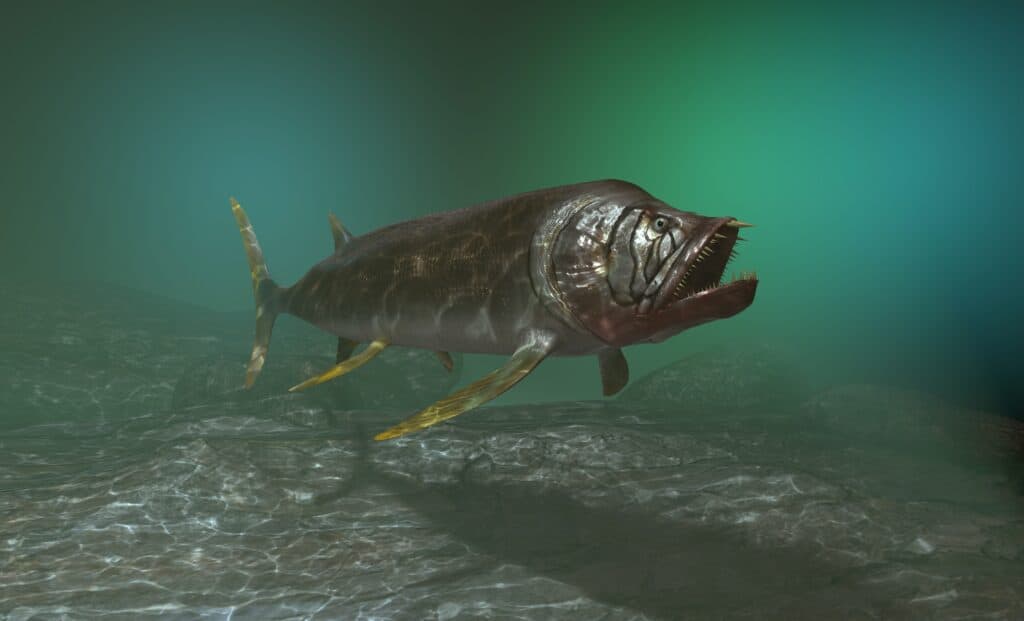Xiphactinus
Xiphactinus audax
Xiphactinus was the largest bony fish of the Cretaceous Period.
Advertisement
Xiphactinus Facts
- Prey
- Fish, small marine reptiles, cephalopods
- Fun Fact
- Xiphactinus was the largest bony fish of the Cretaceous Period.
- Biggest Threat
- Large aquatic reptiles and primitive sharks
- Most Distinctive Feature
- Xiphactinus had a long, slender body
- Distinctive Feature
- Xiphactinus had a massive jaw with long and sharp teeth
- Habitat
- Western Interior Seaway
- Predators
- Primitive sharks and large sea reptiles
- Diet
- Carnivore
- Type
- Extinct marine bony fish
- Number Of Species
- 2
- Location
- North America
View all of the Xiphactinus images!
The Xiphactinus is an extinct genus of bony fish that lived during the Late Cretaceous. This voracious sea creature lived in the Western Interior Seaway and was a top predator at the time. It was one of the largest bony fish to have ever lived. This massive bony fish lived during the Cretaceous Period (112 million years ago) and was alive until the end of the period about 65 million years ago.
Description and Size

is a Greek word that translates to “sword ray.”
©Esteban De Armas/Shutterstock.com
The Xiphactinus was a ferocious predator that lived during the Late Cretaceous Period. The name Xiphactinus is a Greek word that translates to “sword ray.” It belongs to the same class as the fanged tarpon and also looked quite similar in appearance. However, they’re not closely related.
Its known for its sleek and slim torpedo-shaped body. The bony fish also had a massive head with huge jaws that gave it an intimidating appearance. The jaws had razor-sharp teeth, with each tooth measuring several inches in length.
Only two species have been identified in this genus. The biggest of them, the Xiphactinus audax, may have reached lengths of up to 20 feet and weighed up to half a ton. The massive size of this fish meant it was the largest bony fish that lived in the Cretaceous seas of North America. It had winglike pectoral fins with a dorsal fin pointing backward. Pelvic and anal fins were present too, and they pointed downwards. This unique sleek build of this animal suggests that it was built for speed, making powerful strokes with its tail. It was also probably capable of leaping out of the water like a dolphin.
Evolution and History
Xiphactinus emerged during the Late Cretaceous about 112 million years ago. The fish evolved into one of the largest bony fish to have ever lived. Although primitive fishes appeared as early as the Cambrian Period (about 500 million years ago), the Devonian Period is regarded as the actual age of the fishes because this was when the majority of fish species emerged.
Most of the bony fishes living today evolved during the Triassic Period (around 200 million years ago). The earliest bony fishes were classified into lobe-finned and ray-finned fish based on the shape and structure of their fins. Experts believe the lobe-finned fish eventually branched off to evolve into amphibians and other tetrapods. Xiphactinus was a ray-finned fish that went extinct about 65 million years ago.
Diet — What Did Xiphactinus Eat?
The Xiphactinus was a vicious, carnivorous sea beast. It was one of the largest bony fish in its habitat and had a big appetite. It was a generalist predator, which means it preyed on anything it could find in the water, including fish, small marine reptiles, cephalopods, and so on. Experts think it may have also preyed on seabirds like the Hesperornis.
The wild appetite of this fish was one of the most interesting things about its discovery. Experts found many fossils of this creature with undigested prey in their stomachs. One of the most notable ones was a fish-within-a-fish situation where undigested remains of a 6.2 feet long primitive shark (Gillicus arcuatus) were inside the fossil of a 14-foot Xiphactinus. This shows the fish was a formidable predator that caught prey in its massive jaws and swallowed them whole.
The prehistoric fish was a fast swimmer as well. This would have aided its ability to catch prey. Experts think it may have reached speeds of up to 30 miles per hour and could leap out of the water to catch prey on the water’s surface.
Habitat — When and Where It Lived
Back in the Cretaceous, Central North America was submerged under a prehistoric sea known as the Western Interior Seaway. Xiphactinus lived in this ancient ocean along with marine reptiles like the Mosasaurus, Elasmosaurus, and Ichthyosaurus. The very diverse saltwater ecosystem also had organisms at the lower levels, such as mollusks, cephalopods, and small fishes.
Threats and Predators
Although Xiphactinus was a top predator, it wasn’t at the top of the food chain of the Western Interior Seaway. Large marine reptiles such as the mosasaurs and ichthyosaurs were the apex predator in this ecosystem. Ancient sharks like the Squalicorax and Cretoxyrhina were present as well. These large predators may have preyed on the Xiphactinus. Scientists have found a large specimen of Cretoxyrhina with Xiphactinus remains in its abdomen. It isn’t clear whether the shark preyed on the bony fish or just scavenged on its remains.
Discoveries and Fossils
Scientists have found skeletal remains of the Xiphactinus in various locations around the world, including Europe and Australia. However, the most popular fossil discovery site of this genus is the Niobrara Chalk Beds of Kansas, which had several bone fragments. Professor Joseph Leidy found the first fossil of this specimen in 1870. Up to 12 more complete and nearly complete specimens had been recovered from this site, with several more partial skeletons.
Just recently, complete fossils were recovered from the Salamanca Formation in Argentina and the La Luna Formation in Venezuela.
There are two species of Xiphactinus known so far. Xiphactinus audax was the first species to be discovered and is the larger of the two. It had a wide geographical range, with fossils discovered around the world. Xiphactinus vetus was discovered around the eastern part of the United States in 1997.
At least six specimens of Xiphactinus audax have been collected with undigested prey in their stomachs. One of the most famous Xiphactinus fossils ever discovered was the 10-foot-long Cretaceous fish called Gillicus, found partially whole inside the Xiphactinus. Paleontologists believed the Gillicus killed the Xiphactinus while trying to escape its predator. In 2002, Michal Matějka found an incomplete skull that was most likely a new species of Xiphactinus in the Czech Republic.
Extinction — When and Where Did Xiphactinus Die Out
Xiphactinus lived around 112 million years ago during the Late Cretaceous Period. The bony fish survived until the Cretaceous-Palaeogene extinction (about 65 million years ago). Xiphactinus was wiped off along with many other groups of Cretaceous organisms, leaving no living descendants.
Similar Animals to the Xiphactinus
Similar animals to the Xiphactinus include:
- Ichthyodectes — This is an extinct genus of ray-finned fish that lived during the Late Cretaceous Period. It was a swift predator with small teeth and was related to the Xiphactinus audax.
- Cladocyclus — This is an extinct predatory fish that lived in South America during the Late Cretaceous. It was about 3.9 feet long, meaning it was significantly smaller than the Xiphactinus.
- Cretoxyrhina — This is an extinct genus of Mackerel shark that lived in North America around the same time as the Xiphactinus. Cretoxyrhina was one of the largest sharks of the Cretaceous Period and may have preyed on the Xiphactinus.
Related Animals…
View all 13 animals that start with XXiphactinus FAQs (Frequently Asked Questions)
When was Xiphactinus alive?
The Xiphactinus lived during the Late Cretaceous Period about 112 million years ago. It was alive until the Cretaceous-Palaeogene extinction about 66 million years ago.
How big was the Xiphactinus?
Xiphactinus was one of the biggest bony fish ever discovered. It was about 16 to 20 feet long and weighed between 500 and 1,000 pounds.
Was Xiphactinus a shark?
No. Xiphactinus was not a shark. It was a vicious predatory bony fish that lived during the Late Cretaceous. Xiphactinus shared the same habitat with sharks like Cretoxyrhina and Squalicorax.
Thank you for reading! Have some feedback for us? Contact the AZ Animals editorial team.
Sources
- Fossil Era, Available here: http://www.fossilera.com/pages/xiphactinus-terror-of-the-inland-seaway
- Prehistoric Otter, Available here: https://prehistoricotter.co.uk/2021/01/29/xiphactinus-the-beautiful-bull-of-the-sea/
- Thought Co., Available here: https://www.thoughtco.com/history-of-xiphactinus-1093712
- Wikipedia, Available here: http://en.m.wikipedia.org/wiki/Xiphactinus

















